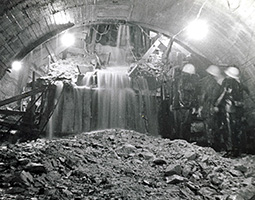Home > Highlighting JAPAN > Highlighting Japan August 2019 > In Praise of Mountains
Highlighting JAPAN


Huge Dam Supports Economy and Attracts Tourism
The Tateyama Kurobe Alpine Route offers travelers a variety of sightseeing opportunities, from majestic mountain scenery to the towering snow walls of Yuki-no-Otani in spring and the changing foliage of the Chubu-Sangaku National Park year-round. Of all the sights along the route, Kurobe Dam is the highlight.
The Japanese islands are cut through with long, narrow, and steep mountain ranges. During the post-war period of high economic growth, hydroelectric power plants utilizing such steep differences in land elevation were built in various locations for the stable supply of electricity. One such plant was the Kurobe No. 4 Power Plant with Kurobe Dam, which was built over seven years from 1956.
Kurobe Dam is a beautiful arched structure, the tallest dam in Japan at 186 m and with a crest length of 492 m. It has yielded many stories, and a feature film has even been made about how the dam was built at such a beautiful yet steep and perilous location.
Chubu-Sangaku National Park, of which Kurobe Dam forms a part, straddles Niigata, Toyama, Gifu and Nagano Prefectures, and is the location of the Hida Mountains (Northern Alps), which have several peaks of more than 3,000 m. The Tateyama Kurobe Alpine Route that runs through the national park is one of the world’s most beautiful mountain sightseeing routes, connecting the mountain sightseeing areas of Omachi in Nagano and Tateyama in Toyama. The greatest difference in elevation is 1,975 m. The route can be traversed by switching between bus, cable car and ropeway.
At Kurobe Dam, you can enjoy the impressive discharge of water that comes from the huge dam or hop on the ferry that crosses the dam lake beneath the Tateyama and Ushiro-Tateyama Mountain Ranges. About 1 million tourists come here every year.
Kansai Electric Power Company, Incorporated has managed the Kurobe Dam. Misako Noguchi, a subsection chief of the Hokuriku Branch Chief Communication Group of the company, says, “After the Second World War, the Kansai area suffered from serious lack of electricity with continuous planned outages at factories and in ordinary homes. To resolve this, the decision was made to develop the upper reaches of the Kurobe River, a project that had not materialized due to the harsh natural environment and technical challenges. The construction of the Kurobe Dam and the Kurobe River No. 4 Hydropower Plant was an unprecedentedly massive project that required the manpower of a total of 10 million man-days and a total construction cost of about 51.3 billion yen at the time (482 million US dollars). The company staked its future on the project.”
Hydropower was the principal source of power in Japan until the 1950s, and the steep Kurobe River with its abundant volumes of water had been flagged as an ideal location for a hydropower plant for some time. However, in that inhospitable gorge covered in snow about five months of the year and rarely visited by humans, just taking measurements meant risking your life.
The development of the Kurobe River’s power resources started in the 1910s, and by 1950, only five power plants had been built downstream of the Kurobe Dam. At this time, the construction materials were carried by the railway line that is now operated as the Kurobe Gorge Railway for sightseeing between Unazuki and Keyakidaira in Toyama. In order to build a large dam in a more remote location further upstream, it was crucial to have a different route for transporting materials and machinery, so work was commenced to dig a tunnel 5.4 km in total length between Omachi in Nagano and the dam location.
Yet after digging to roughly the halfway point of the tunnel, workers ran into a soft stratum (fault fracture zone) from which 660 liters of groundwater and sediment gushed forth every second, and this became the biggest challenge of the Kurobe Dam construction project. Construction was extremely difficult, but the latest construction technology of that day was used expertly to get through the approximately 80 m-wide fault fracture zone over the course of seven months. About two years after digging started, the Omachi Tunnel was opened in 1958. In this way, the Kurobe Dam and the Kurobe River No. 4 Hydropower Plant were completed in 1963, greatly contributing to the development of heavy industry, stable living for the people, and post-war reconstruction in the Kansai area.
Noguchi says, “The Kurobe Dam is an important part of society infrastructure, but it is also attractive in terms of sightseeing. Since it’s in the national park, care was taken from the outset of construction to bury power plant facilities underground and otherwise spare the environment.”
The material transportation tunnel is currently a part of the Alpine Route and known as the “Kanden Tunnel.” Since its opening for tourism, a zero-emissions trolleybus had been running for the enjoyment of tourists, but from April this year, it has been replaced by an electric bus.
The maximum output of the Kurobe River No. 4 Hydropower Plant is 335,000 kW, placing it fourth in Japan among general hydropower plants in terms of power generation capacity. Hydropower has the advantage that it can flexibly adapt to changes in electric consumption. Even today, fifty-six years after its construction, Kurobe Dam is not only playing a major role in supporting society but also continues to enchant its visitors.
© 2009 Cabinet Office, Government of Japan








